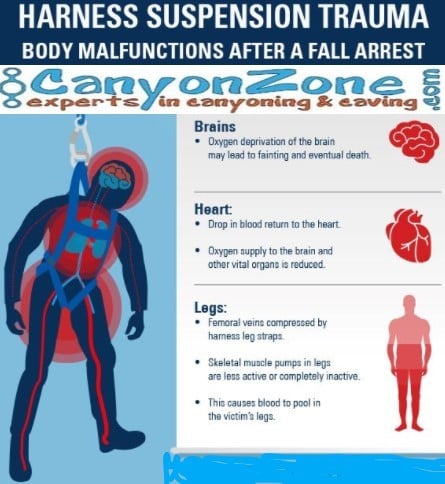What is harness suspension trauma and how do you prevent it?
Falling from heights is still one of the (most) common causes of fatal accidents in outdoor sports. When you have the right fall protection and have it maintained regularly, you are protected against a possible fall.
But after a fall, there is another danger that is often forgotten: harness suspension trauma. It doesn't happen often, but it can be life-threatening for those hanging in the air.
We go deeper into the cause of the suspension trauma, prevention and what to do after rescuing a victim.
What is harness suspension trauma?
Harness suspension trauma is the medical effect of not being able to move in a vertical position. The official term is orthostatic intolerance.
The term often occurs in discussions about fall protection. When someone hangs vertically in the air after a fall, the leg straps of the fall harness exert pressure on the thighs.
This causes the blood vessels to tighten, causing too much blood to build up in the legs. This means that the rest of your body and your brain does not get enough oxygen. The consequences can quickly be fatal if not acted quickly enough.
An important nuance: immobility is the determining factor. The danger only occurs when someone does not move or forgets to move because of the shock.

To understand what happens to your body when you are in the air, let's assume a normal situation:
- Your heart pumps blood to all organs and parts of the body, including your legs. Meanwhile, gravity also helps to keep the blood there. But only blood in your legs, you don't want that.
- In addition, your heart has one major disadvantage: it can only pump blood, not suck it up.
- So the blood has to go back up to your heart through the lungs. Fortunately, we have developed a method that pumps the blood back up. Those are the muscle pumps
- The blood vessels in your legs lie between muscles. When you move your legs, the muscles squeeze your blood vessels and pump the blood back up. These blood vessels contain valves that work in one direction. With every movement or contraction of the muscles, the blood gets a little closer to the heart.
With suspension trauma, there are 3 factors that disrupt your normal circulation:
- Lack of movement
- Closing the blood vessels
- Accumulation of toxic substances
Lack of movement
If you don't move or can't move (due to the harness, fatigue or injury), your muscles can't pump the blood back up either. In this way you lose blood, as it were, and you go into shock.
Getting yourself moving is a temporary solution, but over time, fatigue will also set in.
Closing the blood vessels
Blood vessels are very pliable. As a result, they can quickly shut down. That way, more and more blood builds up in your legs.
Because your brain does not get enough blood and oxygen, you will pass out after a few minutes. At this point, your body says STOP and you fall over. That trap is important because it allows blood to flow back to the brain.
Accumulation of toxic substances
When your blood vessels close off, liters of blood accumulate.
This means there is less available to supply oxygen to the rest of your body.
The result: your organs and muscles produce bad, toxic substances to survive. If the toxicity becomes too high, this will eventually also be fatal for the victim.
Symptoms
If the muscles no longer pump upwards, you lose blood. In a first phase you will become dizzy, you will start to sweat, you will have anxiety attacks and general shock symptoms. Your heart rate and breathing will gradually increase.
Eventually, so little blood will flow to your brain that your heart rate and blood pressure suddenly drop rapidly. You will lose consciousness in no time. Your brain will eventually suffer irreversible brain damage due to the inadequate supply.
If you cannot save the victim quickly enough, it is therefore in danger of life due to closed airways, too little blood or thrombosis.
Prevention
How can you prevent the harness suspension trauma? What things should your employees know before they start working at heights?
First and foremost, it is important that you have a good rescue plan and that you are. It is often a matter of minutes and seconds that are crucial and can save a human life.
The rescue team must always be present and use the correct materials. Working alone at height is not a good idea. Staying in touch with your team is very important.
The next step is to choose a suitable fall harness. Harnesses with integrated relieve straps (suspension straps) are preferred. You use these straps as a support point to stay upright. For instance The AV Muruck.
Investing in good equipment is very important here. The faster you get to the ground, the better.
Do everything you can to rescue the victim from his situation as quickly as possible. A descent system is the ideal way to quickly get the victim to the ground.
After the rescue
It's not over after you rescue the victim. There is one more thing to keep in mind.
The blood that has accumulated in the legs is of poor quality. It is low in oxygen and saturated with CO2. If you lay the victim in a supine position, the bad blood would flow back to the brain in one go. We call this the reflow syndrome.
To avoid this, hold the victim in a sitting position with the torso upright and the legs bent at the knees (W position). For example, a small amount of blood can go to the brain, but the large part remains in the legs.
If the person is unconscious, keep them in an upright sitting position but make sure to keep the airway clear.
If you have to resuscitate, you should always stretch the victim. Without a heartbeat, the blood stays where it is. In any case, you should always call in expert help after a rescue.
Conclusions
- The suspension trauma is very complex. Medical, but also practical. Even though it is rare, it is important to include it in your risk and rescue plans and to implement preventive policies.
- Whether you work at an altitude of 3, 10 or 100 meters, you must encourage your fellow athletes to work safely at height.
- Correct use of harnesses, ropes, rescue system is one piece of your rescue plan.
- Training and awareness are just as important.
Overview Knowledge base Technical terms for canyoning and caving: Go back


